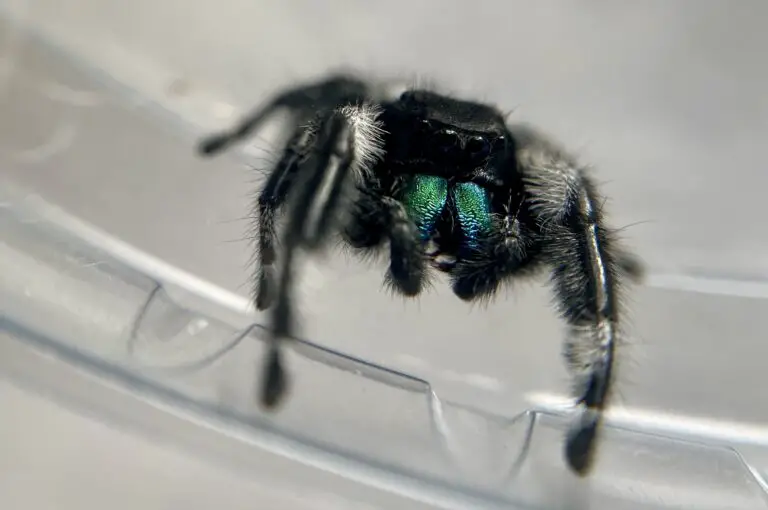Handling Jumping Spiders: How to Make the Experience Enjoyable for Both
With how cute these little creatures are, handling jumping spiders can be one of the best parts of having them as pets.
That said, a lot of people who own jumping spiders believe handling them does not improve their life quality. This can depend solely on the individual spider, however. While some jumping spiders are naturally more prone to biting or can be skittish, others are quite comfortable with being handled by their owners.
There are ways you can prepare yourself and your jumping spider for handling.
Preparation Tips for Handling Jumping Spiders
No matter if it is the first time you are holding your spider or if you’ve done it hundreds of times, you want to approach the little one cautiously. They can find sudden movements frightening; this can often trigger their fight or flight reflex, meaning they could either bite you or hide from you. Either option is not the aim when handling your spider.
Here are some top tips to follow before you begin handling your jumping spider:
Ensure Your Jumping Spider isn't in Pre-Molt
As discussed here, molting can be a dangerous time for a jumping spider. This includes pre-molt as they are preparing to shed their exoskeleton.
Due to the additional risk to your spider’s life at this time, it is best to leave them until they have molted and are roaming their enclosure once again.
Wash Your Hands
Before you even think about handling your spider, be sure to wash your hands. Any chemicals, dirt or oils can be harmful to your spider if transferred.

If you are unsure if your hands are completely clean, you can always wear a pair of gloves. These can be purchased from any hardware store.
Use a Clear Table or Desk
If you can, bring the jumping spider’s enclosure to a clear area, preferably a table or a desk. If this is not possible, clear the table or desk of any items that could be in the way.
This will limit the number of places your spider can hide. It will also ensure there is nothing that can be knocked accidentally; you want to avoid things moving or falling as this can frighten, injure, or even kill your spider.
Have a Plastic Cup to Hand
Having a plastic cup, or another container, to hand is essential; this is just in case the jumping spider decides to attempt a great escape. You want to minimize the risk of losing your spider.
If you are worried about harming your spider by putting them in the cup, you can always place the cup over the spider. This will allow you to pick up the cup, and the spider, with both hands and can help you avoid squishing your spider.
Ways of Correctly Handling Jumping Spiders
Method 1 - Guiding
For this method, you need a straw, paintbrush, or something similar. You want to use this in order to guide your spider out of its enclosure.
First things first, you will need to gently tap your spider with the straw. Once you have gotten their attention, you need to then guide them out of the enclosure. You can do this by holding the straw close to them and gently moving it towards the edge of the enclosure. If you have a paintbrush, you can use this instead.
Once your spider is out of the enclosure, you can then gently encourage them on to your hand using the straw or paintbrush. If you are worried about whether your jumping spider might bite you, you can always use a pair of gloves and place the spider in them.
Method 2 - Tricking
To trick your spider so it jumps onto your hand, you need to know the indicator a jumping spider is about to jump. This is often when they begin waving their front legs in the air; it is almost like they are reaching to grab onto something.
Once they exhibit this behavior, you can offer one of your hands as a place to jump. Do this slowly to avoid the spider from becoming scared. Your spider might jump on to your hand then jump right back. This is okay; just make sure you don’t move your hand too abruptly as this might cause you to lose your spider.
If your spider begins to walk up your arm, you can then gently support it.
No matter the method you choose, you do not want to use your fingers to scoop up your spider or grab them; they are fragile and can be injured this way.
Once your jumping spider is comfortable on your hand, it will likely begin to walk or jump from one hand to the next; you can encourage this by placing your hands in front of each other. This will help create a path for the jumping spider to follow.
You can then place the jumping spider back in their enclosure by gently placing the hand they are on near the entry point to the enclosure. If you are worried about them escaping, you can always place a plastic cup over the spider and gently place it back in the enclosure.
But don’t be disheartened if your jumping spider has no interest in being handled. Some jumping spiders just don’t like it and would rather stay in their enclosure. If you do choose to attempt handling jumping spiders, remember that not all spiders will be comfortable with it. It’s important to pay attention to your spider’s body language and respect its boundaries. If your jumping spider shows signs of stress, such as trying to escape or becoming defensive, it’s best to give them space. Remember, handling jumping spiders should always be a positive experience for both you and your pet, and it’s okay to let your spider enjoy its environment without being handled if that’s what they prefer.

